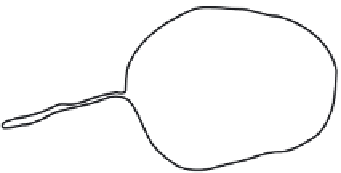Agriculture Reference
In-Depth Information
Table 16.1
Summary of World Potato Supply Statistics (1993-1997).
Continent
Planting (000 ha)
Yield (t/ha)
Production (000 t)
Africa
737.6
11.5
8457
Asia
7476.1
14.1
105 532
Eastern Europe
6716.1
13.0
87 301
Latin America and Caribbean
1051.8
13.3
13 967
North America
691.0
35.6
24 593
Oceania
50.3
29.6
1489
Western Europe
1538.7
32.1
49 408
World
18262
15.9
290 746
Source: FAO (1999).
Bud end
Skin
Cortex
Eye
Vascular ring
Perimedullary zone
Medullary rays
Lenticels
Scale leaf
Pith
Bud
Underground stem
Stem end
Apical bud
Tuber
Figure 16.1
Structure of the potato tuber (Diop and Calverley 1998, with permission of FAO).
Composition of potato tubers
The composition of potato tubers (see Table 16.2) varies
with variety and growing conditions. Dry matter content
varies from less than 20% to almost 50%. Starch constitutes
65% to 80% of the dry weight of the tuber. Potatoes are
also an important source of protein, iron and riboflavin. In
particular potato is a major source of vitamin C (ascorbic
acid/ dehydroascorbic acid). Vitamin C levels decrease
during the first few weeks of storage, and then more slowly.
A single medium-sized potato is said to have about 50% of
adult daily requirement (CIP 2008).
Wound healing of potato tubers and the practice
of curing
Like many long-lived plant structures, potato tubers are
able to heal wounds. The process involved has been
studied for several decades (Priestley & Woffenden 1923).
The first stage is that cells at the wound surface become
suberized. In this process suberin, a large molecular
complex including aromatic and aliphatic components is
synthesised in the cell wall. Suberin is an important
component of native periderm and suberization is a com-
mon response to wounding of plant organs (Kolattukudy









































































